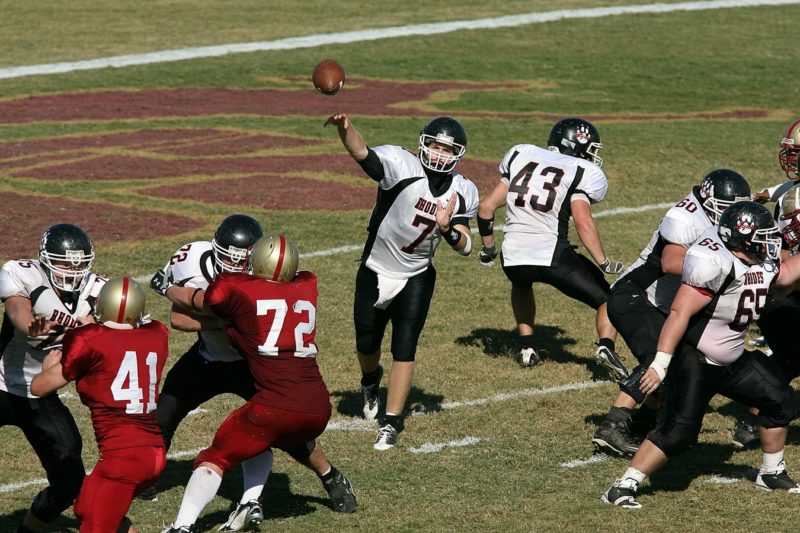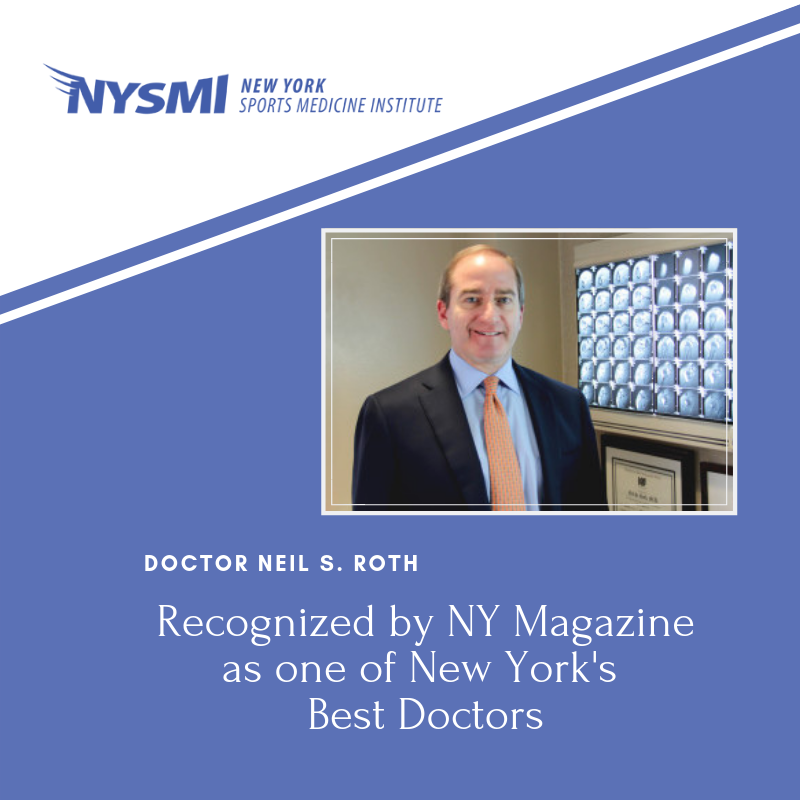
Orthopedic Surgeon Midtown East
New York Sports Medicine Institute | Orthopedics is committed to excellence by providing the highest quality of orthopedic and sports medicine care. Along with the treatment of immediate or chronic problems, NYSMI strives to integrate the doctrine of prevention in all treatment plans as a way to alleviate future difficulties. With the help of our orthopedic surgeon Midtown East, we’re able to provide quality care for our patients.
NYSMI serves patients 3 years old and up, with treatment and surgery for orthopedic and sports injuries, to alleviate shoulder, knee, hip, and various other pains, from the mild to the severe.
Meet Our Orthopedic Surgeon Midtown East – Dr. Neil S. Roth
What Conditions Can an Orthopedic Surgeon MIDTOWN East Treat?
New York Sports Medicine Institute provides a wide range of highly specialized treatments to properly evaluate and treat sports-related and chronic conditions affecting the shoulder, knee, hip, elbow, hand, wrist, foot, and ankle. Sports injuries are often caused by trauma suffered during competition and repetitive or overuse wear and tear. Chronic conditions may include arthritis, age-related deterioration, or any number of factors related to use or associated health issues.
When surgery is required, NYSMI offers minimally invasive arthroscopic surgery for a number of conditions related to injury of the shoulder, knee, hip, elbow, foot, ankle, hand, and wrist. Our orthopedic surgeons are also highly regarded for providing hip, knee, and shoulder total joint replacement.
Physical therapy is frequently prescribed for the treatment of sports injuries and chronic injuries that may not require orthopedic surgery. Physical therapy is also prescribed to ensure optimal healing and training following some orthopedic surgery procedures. For a number of patients, conducting physical therapy at the New York Sports Medicine Institute provides convenience and comfort – a visit to one location serves multiple needs and provides comprehensive care to keep you in the game.
Click to learn more about specific services and ailments
What Does an Orthopedic Surgeon do?

Are you curious to know what a highly skilled orthopedic surgeon is able to do? This particular medical profession is often considered one of the most cutting-edge and in-demand fields in the industry. Not only can an orthopedic surgeon treat various injuries and traumas with both surgical and non-surgical techniques, but some even specialize in certain areas of the body. As the founder of New York Sports Medicine Institute, Dr. Neil S. Roth is a highly acclaimed board-certified orthopedic surgeon who specializes in the area of comprehensive sports medicine, shoulder, elbow, and knee surgery. He has been recognized by New York Magazine as one of New York’s best doctors, as well as Castle Connolly’s top doctors in the New York Metro area. Amongst the list of prestigious doctors, Dr. Roth takes great pride in the acknowledgment of his entire team’s high level of expertise. If you have been looking for a highly distinguished orthopedic surgeon in Manhattan, contact us at New York Sports Medicine Institute. We offer extensive sports medicine treatment, orthopedic surgery, concussion care, and physical therapy at both our Westchester and New York City locations. We recommend you learn more about the various concentrations of orthopedic surgery and how it can help you.
Orthopedic Concentrations
Orthopedic surgery can be used to help treat patients with a wide variety of injuries or other related traumas. Some of the most common conditions orthopedic surgery can help treat may include the following:
- Shoulder Injuries such as:
- Rotator cuff tears.
- Tendonitis and bursitis.
- Arthritis of the shoulder.
- Frozen shoulder.
- Shoulder instability.
- Fractures.
- General shoulder pain.
- Knee injuries such as:
- ACL, MCL, and PCL injuries.
- Meniscus Tear.
- Osteochondritis Dissecans (OCD) of the knee.
- Articular cartilage injury.
- Autologous chondrocyte implantation (ACI).
- Total and partial knee replacement.
- Arthritis of the knee.
- General knee pain.
- Elbow conditions such as:
- Tennis elbow.
- Ligament construction of the elbow.
- Elbow dislocation and instability.
- Osteochondritis of the elbow.
- Hip injuries such as:
- Fractures and tears.
- Hip impingement (FAI).
- Snapping Hip.
- Arthritis of the hip.
- Hip replacement.
- Foot & Ankle conditions such as:
- Sprains, strains, and fractures of the foot and ankle.
- Arthritis of the foot and ankle.
- Tendonitis of the foot and ankle.
- Hand & Wrist complications such as:
- Fractures of the wrist or fingers.
- Tendonitis of the wrist.
- Ganglion cysts.
- Arthritis of the hand and wrist.
- Carpal tunnel syndrome.
The Difference at New York Sports Medicine Institute
At NYSMI, our team is highly specialized in performing orthopedic surgery and treating the above-listed injuries and conditions. Through our expertise, we strive to help each and every one of our patients restore normal and pain-free function back to the affected area. If you have been searching for a skilled orthopedic surgeon Midtown East, contact us at New York Sports Medicine Institute. We want to provide you with the best care possible to get you back to feeling your best!
Orthopedic Surgeon Expertise
Since people tend to visit an orthopedic surgeon when their condition has gotten to a more severe or painful stage, orthopedic surgeons primarily focus on proper diagnosis and treatment for patients.
Diagnosis & Treatment
The various diagnostic tools orthopedic surgeons commonly use involve physical examinations, imaging studies, and lab tests. Treatment options can include both surgical and non-surgical procedures such as:
- Arthroscopic surgery – a surgical procedure using a tiny camera to see inside of a joint, used in different areas of the body.
- Open shoulder instability surgery.
- Rotator cuff surgery.
- Physical therapy treatment.
- Total or partial replacement of the shoulder, hip, or knee.
Depending on your particular injury or severity of your condition, different types of treatment plans may be recommended. It’s important to schedule an appointment with an orthopedic surgeon as soon as an injury takes place or a condition develops.
The Requirements
In order to become a board-certified orthopedic surgeon, there are several different accreditations you must first achieve. You must complete a four-year undergraduate program specifically comprised of one year of biology, one year of physics, and two years of chemistry. Then, followed by an additional four years of medical school and a post-graduate residency program. The residency program focuses solely on the specialty of orthopedic surgery. This allows prospective surgeons to get hands-on, practical exposure to the various surgical techniques and technologies used in this particular medical concentration.
The founder of New York Sports Medicine Institute, Dr. Neil S. Roth, is both a board-certified orthopedic surgeon and sports medicine doctor. He received his undergraduate degree from Duke University School of Medicine in Durham, North Carolina. He went on to complete his postgraduate studies and residency program at Columbia-Presbyterian Medical Center. Amongst the list of accreditations, Dr. Roth has also completed a fellowship in Sports Medicine at the world-renowned Kerlan-Jobe Orthopedic Clinic where he served as an assistant team physician for the Los Angeles Lakers, Dodgers, Kings and Angels, the Anaheim Ducks, and the University of Southern California. His high level of expertise and wide-set knowledge on the subject of sports medicine has set him apart as a skilled orthopedic surgeon.
ORTHOPEDIC TREATMENT FOR SLAP/LABRAL TEARS

Shoulder injuries can derail a once-promising season and even destroy an entire career. At the New York Sports Medicine Institute, we have a proven track record of giving our patients the best care available. Dr. Neil Roth, our orthopedic surgeon Midtown East, can perform the operation you need to avoid long-term complications of SLAP/labrum tears.
What Are SLAP/Labral Tears?
Your labrum is a thick band of tissue that surrounds your shoulder socket and stabilizes the joint. Injuries to this tissue can commonly happen to athletes who participate in sports such as football, baseball, swimming, and weight lifting; due to their reliance on the repeated overhead motion. Because of this, tears can occur throughout the labrum. A SLAP tear is one that affects a specific part of the labrum.
The superior part of your labrum attaches to your biceps tendon. Tears to this region of the labrum are known as SLAP tears. After an athlete suffers a SLAP/labral tear, the help of an orthopedic surgeon Midtown East may be required. Dr. Roth at New York Sports Medicine Institute will be able to operate and repair the injured tissue to get you back in the game.
What Can Cause These Injuries?
As stated above, those who participate in sports that require repetitive overhead motion are particularly at risk for a labrum tear. However, other events may lead to this injury taking place. If you are affected by any of the below, a trip to an orthopedic surgeon Midtown East may be in your future:
- Trauma such as a fracture or dislocation.
- Wear and tear to the shoulder.
- A forceful tug applied to the arm.
Symptoms:
The sooner you know you have suffered a SLAP/labral tear, the sooner you can begin to seek out treatment. Looking for the following symptoms after a shoulder injury can help determine if this tissue has been torn:
- Deep, achy pain experienced in the shoulder.
- Pain when performing overhead motions.
- Shoulder weakness.
- Instability of the joint.
- Limited range of motion.
Treatment From Our Orthopedic Surgeon MIDTOWN East
At the New York Sports Medicine Institute, we know our patients hate missing time due to injury. Dr. Roth, our orthopedic surgeon Midtown East, can perform surgery to repair the injured tissue. What takes place during the operation will directly depend on the tear itself. Tears resulting from instability (such as dislocations) will see the labrum reattached to the rim of the socket. For SLAP tears, the labrum may only need to be trimmed. However, with severe SLAP tears, the tissue will need to be re-attached to the top of the socket.
Recovering From Surgery:
The final stretch of orthopedic treatment will begin after a successful shoulder operation. You’ll most likely be placed in a sling to keep the joint immobilized to let the surgically repaired labrum properly heal. This will allow any remaining swelling to go down as well. Once Dr. Roth has given the green light, you’ll begin working on regaining the strength and range of motion that was lost due to the injury. Undergoing physical therapy at New York Sports Medicine Institute as an ancillary form of treatment to surgery can help you heal properly and regain proper motioning.
Visit The New York Sports Medicine Institute:
Athletes should not have to worry about the lasting effects an injury can bring. Our team at New York Sports Medicine Institute knows the importance of making a full recovery, which is why we focus on providing exemplary care. Undergoing treatment with our orthopedic surgeon Midtown East will make all the difference in your recovery. Request an appointment with Dr. Roth today and start your journey back to the competition.
What Is The Number One Sports Injury

Orthopedic Surgeon Midtown East
Are you suffering from a sports injury? Are you searching for sports medicine in Manhattan? New York Sports Medicine can help! New York Sports Medicine services include orthopedic sports medicine and concussion care. Orthopedic surgeons Doctor Roth and Doctor Delaney provide quality, compassionate care and treatment for all patients. Dr. Roth and Dr. Dedlaney have experience with all types of sports injuries. They enjoy helping athletes recover and get back to doing what they love. Continue reading below to learn more about sports injuries.
What is the number one sports injury?
The number one sports injury is a knee injury. About 55% of sports injuries occur in the knee. A knee occurs when your knee cap grinds against your leg bone. This results in damage to the kneecap tissue and causes pain. If knee injuries go untreated, they can drastically impact your ability to do what you love.
What are the most common sports injuries?
In addition to knee injuries, there are several other very common sports injuries. Six other common sports injuries are ACL Tear, tennis or golf elbow, shin splints, groin pull, sciatica, and hamstring strain.
Your ACL is responsible for connecting your thig to your shinbone at your knee. Any sudden movements like stopping or changing directions or landing with a hard impact can strain or tear your ACL.
Tennis or elbow is when the tendons in your elbow degenerate due to repeated motions like a backhand in tennis. The golf elbow is caused by the inflammation of your epicondyle, which affects the inside of your elbow.
Shin splints are characterized by shooting pain down the front of your leg. This injury is commonly seen in runners and is sometimes the result of a stress fracture in your bone.
A groin pull deals with the muscles in your inner thigh or groin that are used to help pull your legs together. It typically occurs when you change directions suddenly.
Sciatica refers to the pain on your sciatic nerve path, which is from your lower back through your hips and butt and down your leg. This is typically caused by improper stretching and typically only affects one side of your body.
Hamstring strain commonly occurs when you overuse or overstretch your muscles. It can be easily avoided by not overworking your body. Because of the location of the injury, it can take a very long time to heal.
The five common causes of sports injuries
There are many causes of sports injuries, but there are 5 in particular that are the leading causes of sports injury. The five most common causes are overuse, too much too soon, improper rehabilitation, imbalance training sessions, and ignorance. Overuse can be due to a lack of rest which results in there not being enough time for the muscles to recover and heal. Too much too soon happens when an athlete gets injured, and upon healing, they try to jump right back into their pre-injury performance level. You should never do that, and you should always start slow. Improper rehabilitation applies to those who have been injured previously but did not undergo proper reconditioning. Athletes who don’t train to balance out their physique and only focus on specific muscle groups cause muscle imbalances and deformity, which then subjects them to injury. Lastly, ignorance gets athletes injured. If you are experiencing pain or sustained an injury and have the “ill just walk it off” mentality, you will only cause more damage and worsen the injury. No sports injury should ever go untreated, and you should contact a doctor as soon as the injury occurs. If you are injured, you should seek treatment immediately to ensure you make a full recovery and can get back to doing what you love.
How to prevent sports injuries
- Maintain flexibility
- Strengthen your core
- Use proper technique
- Take time to rest
- Ensure proper healing of a previous injury
Contact New York Sports Medicine: Orthopedic Surgeon Midtown East
If you are suffering from a sports injury and are searching for sports medicine in Manhattan, contact New York Sports Medicine today! Fill out the form online to schedule an appointment with one of their five locations across New York and New Jersey.
How Long Can Shoulder Instability Last?

We use our shoulders daily, whether for lifting something overhead, playing sports, or opening the door to a restaurant. We use our shoulders for many daily activities, and we often don’t even notice it because movements are smooth and painless when working normally. The shoulder is a joint made up of a ball, the humeral head, and a socket, the glenoid. While it sounds simple when described as a ball and socket, it is one of the most complex joints within the body because there are other bones surrounding it. For example, your collarbone is a part of the shoulder. Additionally, the muscles and tendons surrounding the shoulder, called the rotator cuff, are a part of this complex joint. If you are experiencing issues with this joint you should contact an Orthopedic Surgeon Midtown East.
Taking good care of your shoulder is imperative because various injuries are associated with the joint. The most common shoulder injuries include a frozen shoulder, a rotator cuff tear, and shoulder instability. In some cases, surgery is necessary to repair and heal shoulder injuries. Every injury is different, which is why you should visit the experts of the New York Sports Medicine Institute. Our Orthopedic Surgeon Midtown East will ensure you get a proper diagnosis and develop a treatment plan that is best for you and your injury. Continue reading to learn more about Shoulder Instability, a common shoulder injury in the young and athletes.
What Is Shoulder Instability And Associated Symptoms?
Shoulder Instability occurs when the ball and socket separate from one another for a few seconds. If the ball and socket separate and do not fall back into their proper formation, this is called a dislocated shoulder. A dislocated shoulder is even more painful than shoulder instability and is considered more severe. Other shoulder parts can tear when the ball and socket are separated. For example, you can experience a rotator cuff tear resulting from the ball and socket separating and putting pressure on those tissues.
Shoulder instability has various causes. One of the most common causes is overuse. This is especially true for baseball athletes and people whose jobs require a lot of shoulder movement and work. Overuse means the area is significantly overactive, leading to muscle weakness and making the site more prone to injury. Additionally, trauma, such as a severe blow to the shoulder, can cause shoulder instability. Some people are more prone to shoulder instability than others. If you are an athlete in a contact sport, you risk developing shoulder instability.
The most common symptoms associated with shoulder instability are:
- Severe pain surrounding the shoulder
- Feeling a popping sensation in the shoulder joint
- Difficulty lifting the arm overhead
- Feeling that the shoulder cannot move out of a specific position
These symptoms can make movements and everyday life difficult. Our Orthopedic Surgeon Midtown East is ready to help treat you and get you back to feeling pain-free.
What Are The Treatment Options For Shoulder Instability At An Orthopedic Surgeon Midtown East?
Treatment options vary depending on the specific injury. More invasive measures may be necessary if other injuries, such as a tear, are associated with shoulder instability. Our Orthopedic Surgeon Midtown East will utilize imaging techniques such as an X-ray or MRI to look for tears and breaks in the bones and ligaments surrounding the shoulder. If there are no additional injuries to the area, physical therapy is usually the first treatment option recommended. Physical therapy is a standard recommendation because you can build strength around the shoulder to help the joint heal without needing surgery. Many patients prefer that because surgery can be expensive and increase recovery time. However, surgery may be necessary to repair tears around the shoulder. Physical therapy can only be so helpful so far in some cases. If you receive surgery for shoulder instability, you will likely experience at least three months of recovery. Additionally, you may not be able to participate in particular sports for longer.
If you do not get surgery for shoulder instability, the duration of your recovery depends on how often you attend physical therapy and utilize safe shoulder exercises. The more you go to physical therapy and develop strength around the shoulder, your recovery time will likely be shorter. We understand that every injury is different, and everyone’s treatment plan will look different. If you are experiencing shoulder instability and are looking for treatment, our Orthopedic Surgeon Midtown East will help you navigate your injury and develop a treatment plan that is right for you.
Contact Us: Orthopedic Surgeon Midtown East
The physician team at New York Sports Medicine Institute is here to help you get back to feeling pain-free. We have years of experience helping our patients get pain-free and back to enjoying the sports and activities they love. We will use our state-of-the-art techniques and technology to treat your injury and help you make a remarkable recovery. Our Orthopedic Surgeon Midtown East is here for you if you are looking for treatment options. Contact us today to schedule an appointment with our experts.







